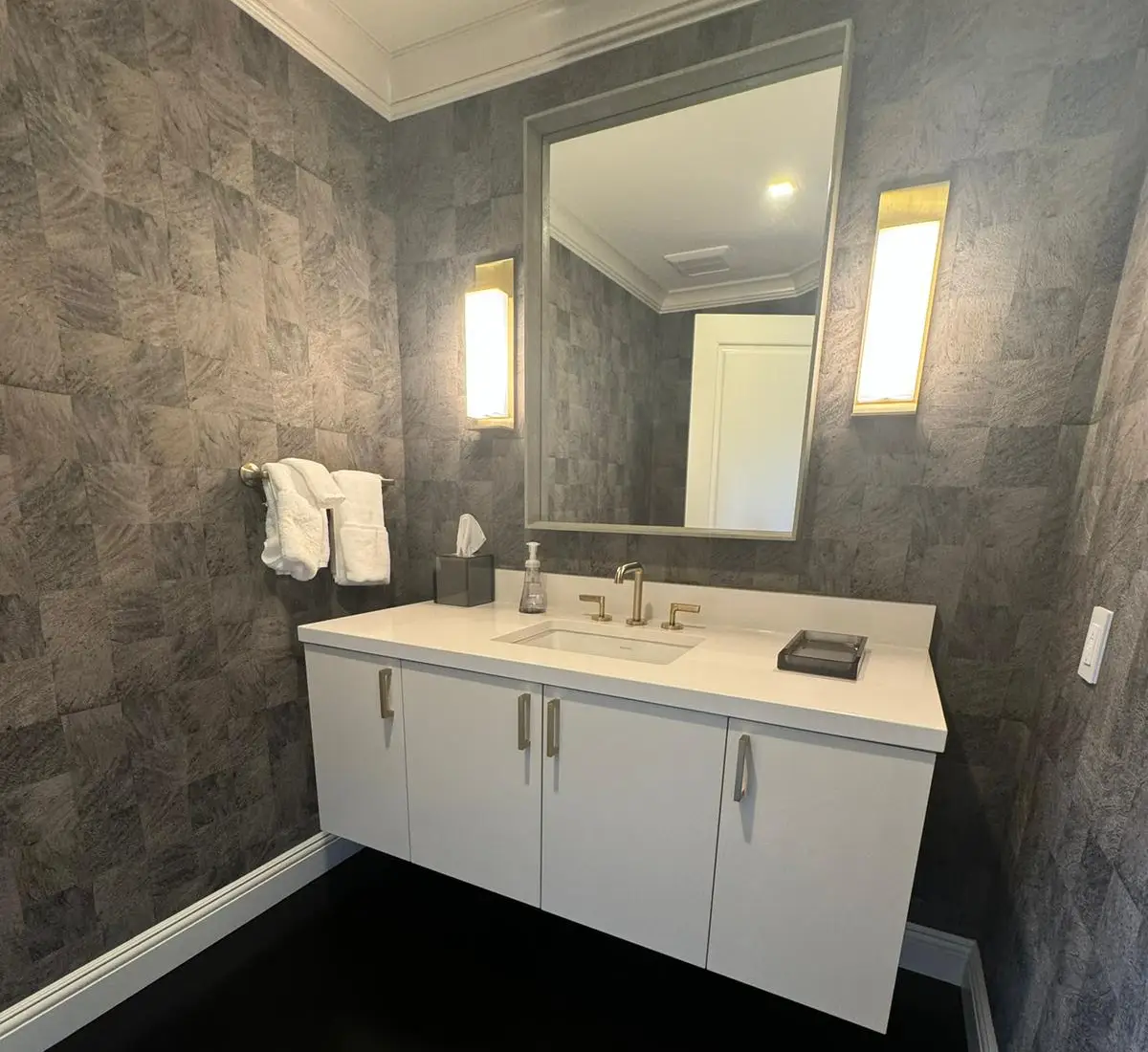Blogs

Best Paint for Bathrooms – Moisture-Resistant & Durable Options
The bathroom is a unique environment within your home, characterized by fluctuating temperatures, high humidity, and consistent moisture. These conditions make it particularly challenging for standard paints, which can quickly fall victim to peeling, blistering, and the unwelcome growth of mold and mildew. Therefore, selecting what kind of paint to use in a bathroom is not just about aesthetics; it's about choosing a formulation designed to withstand these harsh elements, ensuring durability, easy maintenance, and a healthy indoor environment.
Moisture-resistant vs. Regular paint types
When painting a bathroom, the primary distinction you need to understand is between regular interior paints and those formulated with moisture resistance in mind.
Regular Interior Paints (Standard Latex/Acrylic):
Composition: These paints are excellent for living rooms, bedrooms, and hallways. They are designed for general wear and tear but are not specifically formulated to repel constant moisture or resist mold and mildew.
Performance in Bathroom: In a bathroom, standard paints can quickly absorb moisture, leading to bubbles, peeling, and a compromised finish. They also lack sufficient mildewcides, making them highly susceptible to mold and mildew growth in damp conditions.
Moisture-Resistant Bathroom Paints (Often labeled "Kitchen & Bath" or "Mildew Resistant"):
Composition: These paints are typically acrylic-latex formulations with added mildewcides (fungicides) and often have a tighter molecular structure that forms a more durable, water-repellent film. Some may incorporate ceramic microspheres for added durability and washability.
Performance in Bathroom: They are designed to withstand high humidity, prevent moisture penetration, and actively inhibit the growth of mold and mildew, making them ideal for bathrooms. They also tend to be more washable and scrubbable, which is beneficial in a high-traffic, splash-prone area.
Key takeaway: Always opt for paints specifically labeled for bathrooms or high-humidity areas.
Sheen levels: Satin vs. Semi-Gloss vs. Matte
The paint's sheen (or finish) plays a crucial role in its durability, washability, and resistance to moisture. Higher sheens generally offer better protection in bathrooms.
Matte/Flat:
Pros: Hides imperfections well, offers a soft, non-reflective finish.
Cons: Least durable, least washable, and most prone to absorbing moisture. Not recommended for bathroom walls or ceilings as it's highly susceptible to mold and difficult to clean.
Eggshell:
Pros: Slightly more durable than flat, offers a very subtle sheen, good for hiding minor wall imperfections.
Cons: Still not ideal for high-humidity bathrooms. Better suited for low-traffic powder rooms with excellent ventilation.
Satin:
Pros: This is often the minimum recommended sheen for bathroom walls. It offers a soft, pearl-like luster, is highly durable, washable, and more moisture-resistant than flatter finishes. It's a good balance between aesthetics and performance.
Cons: May show wall imperfections more than flat.
Semi-Gloss:
Pros: Highly durable, very easy to clean and scrub, and excellent at repelling moisture and inhibiting mold growth due to its hard, smooth surface. It provides a noticeable shine.
Cons: Can be too reflective for some tastes, and will highlight every wall imperfection.
Best Use: Ideal for bathroom trim (baseboards, door frames, windows) where durability and washability are paramount. Can also be used on walls for maximum protection, especially in very high-humidity bathrooms.
High-Gloss:
Pros: Most durable, most washable, extremely moisture-resistant.
Cons: Very reflective, accentuates every flaw, generally too intense for entire bathroom walls. Best reserved for specific accent areas if desired.
Recommendation: For bathroom walls and ceilings, satin is generally the best balance for aesthetics and performance. For trim, semi-gloss is the superior choice.
Choosing paint based on humidity and use
The level of humidity and how frequently the bathroom is used should influence your paint choice.
High-Humidity Bathrooms (e.g., primary bathroom with shower/tub, little ventilation):
Recommendation: Absolutely use a dedicated "Kitchen & Bath" paint in a satin or semi-gloss finish. Consider using a primer specifically designed for high-moisture areas before painting, especially if mold has been an issue previously.
Ventilation is Key: No paint can completely overcome poor ventilation. Always run the exhaust fan during and after showers/baths for at least 15-20 minutes.
Medium-Humidity Bathrooms (e.g., guest bathroom with shower, decent ventilation):
Recommendation: A good quality, durable acrylic-latex paint in a satin finish is usually sufficient. A "Kitchen & Bath" formula still offers added peace of mind.
Low-Humidity Bathrooms (e.g., powder room/half bath with no shower/tub):
Recommendation: You have more flexibility here. A durable eggshell or satin finish in a standard interior paint will generally perform well, as prolonged moisture exposure isn't a primary concern.
Safe coats: Mildew-inhibiting paint additives
Even if you choose a paint specifically designed for bathrooms, sometimes extra protection is desired, especially in persistently damp environments or if you're using a standard paint with a higher sheen in a powder room.
Mildewcide Additives: These are liquid concentrates that can be mixed into your paint (typically a gallon) to enhance its mold and mildew resistance.
How they work: They contain fungicides that inhibit fungal growth on the paint film.
When to use: If you're concerned about past mold issues, live in a very humid climate, or want an extra layer of protection.
Important: Follow the additive's instructions carefully for proper mixing ratios. Do not over-add, as it can affect paint performance. While helpful, they are not a substitute for a dedicated "Kitchen & Bath" paint's comprehensive moisture resistance.
Note on Primer: For optimal adhesion and mold prevention, especially when painting over existing mold or in high-humidity areas, consider using a mold-killing primer or a moisture-resistant primer before applying your topcoats.
Color durability in steam-prone areas
While the type and sheen of paint are most critical for durability, color choice can also play a subtle role in how wear and tear appear over time in a bathroom.
Lighter Colors (Whites, Off-Whites, Light Pastels):
Pros: Can make a small bathroom feel larger and brighter. Tend to show less fading from sunlight.
Cons: May highlight soap scum, water spots, or minor mildew stains more readily, requiring more frequent spot cleaning.
Mid-Tone Colors:
Pros: Can be very forgiving, masking minor imperfections and light staining better than very light or very dark colors.
Cons: Can still show water marks if not wiped down.
Darker Colors:
Pros: Can create a dramatic, luxurious, or cozy feel.
Cons: Can show water spots and soap film more noticeably if not wiped clean regularly after showers. May also show dust accumulation more.
Fading: While modern paints resist fading, any color can slightly dull over time in areas of constant steam, though this is usually imperceptible.
The best color for your bathroom is ultimately a personal choice, but ensure that regardless of the hue, it's applied in the correct type and sheen of paint for the demanding bathroom environment.
Choosing the right paint for your bathroom is a crucial decision that ensures both beauty and longevity. By understanding the importance of moisture resistance, selecting the appropriate sheen, and considering your bathroom's specific conditions, you can create a durable, healthy, and stunning space. For professional advice and flawless execution, Masterpiece Painter brings expertise and precision to every project, ensuring your bathroom paint stands the test of time and humidity.
Ready to transform your bathroom with the right paint? Contact Masterpiece Painter today for a consultation and bring your vision to life!
About Masterpiece Painter
For over 17 years Masterpiece Painter, has been serving communities all around New England. Let us help you make your wishes come true by turning your property into a Masterpiece
Get a Quote

© copyright 2023 All Rights Reserved.



